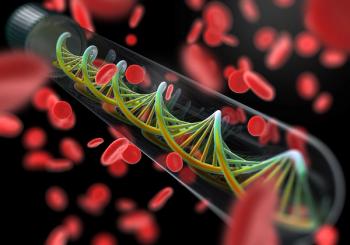
Oncology NEWS International
- Oncology NEWS International Vol 9 No 7
- Volume 9
- Issue 7
Antibody to VEGF Plus Carboplatin/Paclitaxel Improves Outcomes in Previously Untreated NSCLC
KNOXVILLE, Tennessee-An experimental protocol that adds an anti-VEGF agent to carboplatin (Paraplatin)/paclitaxel (Taxol) chemotherapy may improve outcomes more than chemotherapy alone in patients with previously untreated advanced non–small-cell lung cancer (NSCLC).
KNOXVILLE, TennesseeAn experimental protocol that adds an anti-VEGF agent to carboplatin (Paraplatin)/paclitaxel (Taxol) chemotherapy may improve outcomes more than chemotherapy alone in patients with previously untreated advanced nonsmall-cell lung cancer (NSCLC).
At the ASCO meeting, Russell F. DeVore, MD, of East Tennessee Oncology/Hematology, Knoxville, reported preliminary results from a multicenter phase II study of 99 patients who received recombinant humanized monoclonal antibody to vascular endothelial cell growth factor (rhuMAb VEGF).
Patients were randomized to a control arm of conventional carboplatin AUC 6 and paclitaxel 200 mg/m² over 2 hours every 3 weeks, or the experimental arm, which was the same chemotherapy regimen plus rhuMAb VEGF at 7.5 mg/kg (low dose) or 15 mg/kg (high dose), for six cycles or until disease progression.
Patients in the low-dose anti-VEGF arm or the control arm were allowed to cross over to the high-dose anti-VEGF arm at disease progression.
Higher Response Rates
Improvements in both response rates and time to progression were noted for patients receiving the chemotherapy plus high-dose anti-VEGF therapy, Dr. DeVore reported. Outcomes were assessed both by the investigators and by an independent review panel. The independent reviewers also determined responses according to the presence or absence of cavitation (a 50% reduction in the area within a cavity).
Patients receiving high-dose anti-VEGF had a response rate of 40%, according to the independent review panel. By investigator analysis, response rate was 31% in this arm. In the control arm, the response rates were 31% by independent review and 19% by investigator review; responses in the low-dose arm were 21% and 28%, respectively, he said.
Patients with cavitation, according to the independent reviewers, had the highest response rates to anti-VEGF high-dose therapy: 51% vs 31% in controls and 25% in the low-dose arm.
Time to progression was also improved in the high-dose anti-VEGF arm: 7.4 months vs 4.2 for controls and 4.3 for the low-dose arm by investigator review. By independent review, time to progression was 7 months in the high-dose arm, 6 months in the control arm, and 3.9 months in the low-dose arm, Dr. DeVore reported.
I asked the statisticians how we could have such an increase in the time to progression in the control arm. There were seven patients in whom the independent reviewers disagreed with the investigators in terms of time to progression. Three of those were determined to be longer times to progression, three to be lesser, and one was censored because the tumor did not meet the definition of progressive disease. So just one patient could make a difference in that increase from 4 to 6 months. These are the hazards of a small trial, Dr. DeVore commented.
Survival Also Improved
Survival was also improved with high-dose therapy: 17.7 months vs 14.9 months in the control arm and 11.6 months in the low-dose arm. While there was a trend toward improvement with anti-VEGF, this secondary endpoint was not designed to evaluate for statistical significance.
Dr. DeVore pointed out that 19 patients on the control arm crossed over to receive anti-VEGF therapy. Among these patients, 6 remained stable for 6 months or more after receiving the novel agent.
Most toxicities were mild. There was an increase in fever, which was not infusion-related, and an increase in diarrhea. Grade 3-4 neutropenia occurred in over two-thirds of all treatment arms. Anti-VEGF was not associated with increases in infection or neuropathy.
Troublesome Side Effects
Two apparently unique side effects were troublesome. Epistaxis occurred in 44% of high-dose patients, and 9% of patients (6 of 66 receiving anti-VEGF) developed life-threatening episodes of hemoptysis.
Dr. DeVore expressed concern about this unexpected finding, although he said the investigators were aware the drug might affect the integrity of the vasculature. Future trials will monitor closely for hemoptysis, the incidence of which is not yet clear, he said.
The bleeding appeared to be coming from the primary tumors, and may have been related to squamous cell histology. Interestingly, it appears these bleeds may be unique to lung cancer, since they have not been seen in other cancer trials of anti-VEGF, he added.
Moving to Phase III Study
The researchers concluded that anti-VEGF at 15 mg/kg every 3 weeks in combination with carboplatin and paclitaxel appears to increase the response rate and time to disease progression. This finding, along with similar findings from the colorectal trials and the activity the drug has exhibited in breast cancer, have justified moving to a definitive phase III Eastern Cooperative Oncology Group (ECOG) trial. The primary endpoint of this trial will be survival.
We have a median survival of 18 months in this trial, despite a certain number of patients experiencing significant hemoptysis. There is evidence of a real effect. ECOG felt this drug was active enough, and the incidence and character of hemoptysis not yet well-defined, justifying going on to a phase III trial, he said.
Articles in this issue
over 25 years ago
Couric Urges Doctors to Talk to Patients About Colon Cancerover 25 years ago
Automated Imaging Notification System Close to Fail-Safeover 25 years ago
Higher Dairy Consumption Linked to Prostate Cancer Riskover 25 years ago
First-Year Funding of Early Detection Research Network Completeover 25 years ago
Gritty Antitobacco Ads and More From Legacy Foundationover 25 years ago
Tositumomab Effective for Low-Grade Follicular Lymphomaover 25 years ago
New Awards Spotlight Courage of Cancer Survivorsover 25 years ago
Hospital Volume Shown to Predict Breast Cancer Outcomeover 25 years ago
New Drug Information Websiteover 25 years ago
NCCN Presents Updated Colorectal Cancer GuidelinesNewsletter
Stay up to date on recent advances in the multidisciplinary approach to cancer.















































































